Mercury (planet)
Mercury (planet)
From Wikipedia, the free encyclopedia
This article is about the planet. For the element and other uses, see Mercury (disambiguation).

Mercury in greyscale, by MESSENGER (2008)
| |||||||||||||
| Designations | |||||||||||||
|---|---|---|---|---|---|---|---|---|---|---|---|---|---|
| Pronunciation | |||||||||||||
| Adjectives | Mercurian,[1] Hermian | ||||||||||||
| Orbital characteristics[4] | |||||||||||||
| Epoch J2000 | |||||||||||||
| Aphelion |
| ||||||||||||
| Perihelion |
| ||||||||||||
| |||||||||||||
| Eccentricity | 0.205 630[2] | ||||||||||||
| 115.88 d[2] | |||||||||||||
Average orbital speed
| 47.362 km/s[2] | ||||||||||||
| 174.796° | |||||||||||||
| Inclination |
| ||||||||||||
| 48.331° | |||||||||||||
| 29.124° | |||||||||||||
| Satellites | None | ||||||||||||
| Physical characteristics | |||||||||||||
Mean radius
| |||||||||||||
| Flattening | 0[6] | ||||||||||||
| |||||||||||||
| Volume |
| ||||||||||||
| Mass |
| ||||||||||||
Mean density
| 5.427 g/cm3[5] | ||||||||||||
| 0.346±0.014[8] | |||||||||||||
| 4.25 km/s[5] | |||||||||||||
Siderealrotation period
|
| ||||||||||||
Equatorial rotation velocity
| 10.892 km/h (3.026 m/s) | ||||||||||||
| 2.04′ ± 0.08′ (to orbit)[8] (0.034°)[2] | |||||||||||||
North poleright ascension
|
| ||||||||||||
North poledeclination
| 61.45°[2] | ||||||||||||
| Albedo | |||||||||||||
| |||||||||||||
| −2.6[11] to 5.7[2][12] | |||||||||||||
| 4.5–13″[2] | |||||||||||||
| Atmosphere[2] | |||||||||||||
Surfacepressure
| trace | ||||||||||||
| Composition by volume | |||||||||||||
Mercury is the smallest and closest to the Sun of the eight planets in the Solar System,[a] with an orbital period of about 88 Earthdays. Seen from Earth, it appears to move around its orbit in about 116 days, which is much faster than any other planet in the Solar System. It has no known natural satellites. The planet is named after the Roman deity Mercury, the messenger to the gods.
Because it has almost no atmosphere to retain heat, Mercury's surface experiences the greatest temperature variation of the planets in the Solar System, ranging from 100 K (−173 °C; −280 °F) at night to 700 K (427 °C; 800 °F) during the day at some equatorial regions. The poles are constantly below 180 K (−93 °C; −136 °F). Mercury's axis has the smallest tilt of any of the Solar System's planets (about 1⁄30 of a degree), but it has the largest orbital eccentricity.[a] At aphelion, Mercury is about 1.5 times as far from the Sun as it is at perihelion. Mercury's surface is heavily cratered and similar in appearance to the Moon, indicating that it has been geologically inactive for billions of years.
Mercury is gravitationally locked and rotates in a way that is unique in the Solar System. As seen relative to the fixed stars, it rotates on its axis exactly three times for every two revolutions it makes around the Sun.[b][13] As seen from the Sun, in a frame of referencethat rotates with the orbital motion, it appears to rotate only once every two Mercurian years. An observer on Mercury would therefore see only one day every two years.
Because Mercury orbits the Sun within Earth's orbit (as does Venus), it can appear in Earth's sky in the morning or the evening, but not in the middle of the night. Also, like Venus and the Moon, it displays a complete range of phases as it moves around its orbit relative to Earth. Although Mercury can appear as a bright object when viewed from Earth, its proximity to the Sun makes it more difficult to see than Venus. Two spacecraft have visited Mercury: Mariner 10 flew by in the 1970s; and MESSENGER, launched in 2004, orbited Mercury over 4,000 times in four years, before exhausting its fuel and crashing into the planet's surface on April 30, 2015.[14][15][16]
Contents
Internal structure
Mercury is one of four terrestrial planets in the Solar System, and is a rocky body like Earth. It is the smallest planet in the Solar System, with an equatorial radius of 2,439.7 kilometres (1,516.0 mi).[2] Mercury is also smaller—albeit more massive—than the largest natural satellites in the Solar System, Ganymede and Titan. Mercury consists of approximately 70% metallic and 30% silicate material.[17] Mercury's density is the second highest in the Solar System at 5.427 g/cm3, only slightly less than Earth's density of 5.515 g/cm3.[2] If the effect ofgravitational compression were to be factored out, the materials of which Mercury is made would be denser, with an uncompressed density of 5.3 g/cm3 versus Earth's 4.4 g/cm3.[18]
Mercury's density can be used to infer details of its inner structure. Although Earth's high density results appreciably from gravitational compression, particularly at the core, Mercury is much smaller and its inner regions are not as compressed. Therefore, for it to have such a high density, its core must be large and rich in iron.[19]
Geologists estimate that Mercury's core occupies about 42% of its volume; for Earth this proportion is 17%. Research published in 2007 suggests that Mercury has a molten core.[20][21]Surrounding the core is a 500–700 km mantle consisting of silicates.[22][23] Based on data from theMariner 10 mission and Earth-based observation, Mercury's crust is estimated to be 100–300 km thick.[24] One distinctive feature of Mercury's surface is the presence of numerous narrow ridges, extending up to several hundred kilometers in length. It is thought that these were formed as Mercury's core and mantle cooled and contracted at a time when the crust had already solidified.[25]
Mercury's core has a higher iron content than that of any other major planet in the Solar System, and several theories have been proposed to explain this. The most widely accepted theory is that Mercury originally had a metal-silicate ratio similar to common chondrite meteorites, thought to be typical of the Solar System's rocky matter, and a mass approximately 2.25 times its current mass.[26] Early in the Solar System's history, Mercury may have been struck by a planetesimal of approximately 1/6 that mass and several thousand kilometers across.[26] The impact would have stripped away much of the original crust and mantle, leaving the core behind as a relatively major component.[26] A similar process, known as the giant impact hypothesis, has been proposed to explain the formation of the Moon.[26]
Alternatively, Mercury may have formed from the solar nebula before the Sun's energy output had stabilized. It would initially have had twice its present mass, but as the protosun contracted, temperatures near Mercury could have been between 2,500 and 3,500 K and possibly even as high as 10,000 K.[27] Much of Mercury's surface rock could have been vaporized at such temperatures, forming an atmosphere of "rock vapor" that could have been carried away by the solar wind.[27]
A third hypothesis proposes that the solar nebula caused drag on the particles from which Mercury was accreting, which meant that lighter particles were lost from the accreting material and not gathered by Mercury.[28] Each hypothesis predicts a different surface composition, and two space missions, MESSENGER and BepiColombo, both will make observations to test them.[29][30]MESSENGER has found higher-than-expected potassium and sulfur levels on the surface, suggesting that the giant impact hypothesis and vaporization of the crust and mantle did not occur because potassium and sulfur would have been driven off by the extreme heat of these events. The findings would seem to favor the third hypothesis; however, further analysis of the data is needed.[31]
Surface geology
Main article: Geology of Mercury
| Topography |
|---|
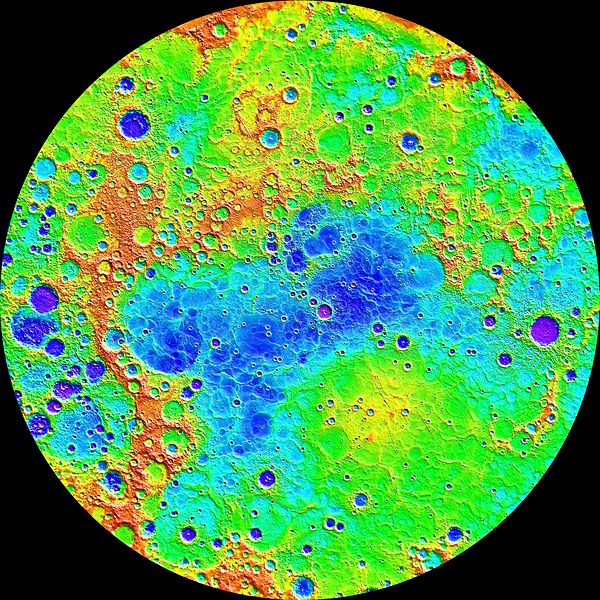 lowest (purple) to 10 km (6.2 mi) highest (red). |
Mercury's surface is similar in appearance to that of the Moon, showing extensive mare-like plains and heavy cratering, indicating that it has been geologically inactive for billions of years. Because knowledge of Mercury's geology has been based only on the 1975 Mariner 10 flyby and terrestrial observations, it is the least understood of the terrestrial planets.[21] As data from MESSENGER orbiter is processed, this knowledge will increase. For example, an unusual crater with radiating troughs has been discovered that scientists called "the spider".[32] It later received the name Apollodorus.[33]
Albedo features are areas of markedly different reflectivity, as seen by telescopic observation. Mercury has dorsa (also called "wrinkle-ridges"), Moon-like highlands, montes (mountains), planitiae (plains), rupes (escarpments), and valles (valleys).[34][35]
Names for features on Mercury come from a variety of sources. Names coming from people are limited to the deceased. Craters are named for artists, musicians, painters, and authors who have made outstanding or fundamental contributions to their field. Ridges, or dorsa, are named for scientists who have contributed to the study of Mercury. Depressions or fossae are named for works of architecture. Montes are named for the word "hot" in a variety of languages. Plains or planitiae are named for Mercuryin various languages. Escarpments or rupēs are named for ships of scientific expeditions. Valleys orvalles are named for radio telescope facilities.[36]
Mercury was heavily bombarded by comets and asteroids during and shortly following its formation 4.6 billion years ago, as well as during a possibly separate subsequent episode called the late heavy bombardment that came to an end 3.8 billion years ago.[37] During this period of intense crater formation, the planet received impacts over its entire surface,[35] facilitated by the lack of any atmosphere to slow impactors down.[38] During this time the planet was volcanically active; basins such as the Caloris Basin were filled by magma, producing smooth plains similar to the maria found on the Moon.[39][40]
Data from the October 2008 flyby of MESSENGER gave researchers a greater appreciation for the jumbled nature of Mercury's surface. Mercury's surface is moreheterogeneous than either Mars's or the Moon's, both of which contain significant stretches of similar geology, such as maria and plateaus.[41]
Impact basins and craters
Craters on Mercury range in diameter from small bowl-shaped cavities to multi-ringed impact basins hundreds of kilometers across. They appear in all states of degradation, from relatively fresh rayed craters to highly degraded crater remnants. Mercurian craters differ subtly from lunar craters in that the area blanketed by their ejecta is much smaller, a consequence of Mercury's stronger surface gravity.[42] According to IAU rules, each new crater must be named after an artist that was famous for more than fifty years, and dead for more than three years, before the date the crater is named.[43]
The largest known crater is Caloris Basin, with a diameter of 1,550 km.[44] The impact that created the Caloris Basin was so powerful that it caused lava eruptions and left a concentric ring over 2 km tall surrounding the impact crater. At the antipode of the Caloris Basin is a large region of unusual, hilly terrain known as the "Weird Terrain". One hypothesis for its origin is that shock waves generated during the Caloris impact traveled around the planet, converging at the basin's antipode (180 degrees away). The resulting high stresses fractured the surface.[45] Alternatively, it has been suggested that this terrain formed as a result of the convergence of ejecta at this basin's antipode.[46]
Overall, about 15 impact basins have been identified on the imaged part of Mercury. A notable basin is the 400 km wide, multi-ring Tolstoj Basin that has an ejecta blanket extending up to 500 km from its rim and a floor that has been filled by smooth plains materials. Beethoven Basin has a similar-sized ejecta blanket and a 625 km diameter rim.[42] Like the Moon, the surface of Mercury has likely incurred the effects of space weathering processes, including Solar wind and micrometeorite impacts.[47]
Plains
There are two geologically distinct plains regions on Mercury.[42][48] Gently rolling, hilly plains in the regions between craters are Mercury's oldest visible surfaces,[42] predating the heavily cratered terrain. These inter-crater plains appear to have obliterated many earlier craters, and show a general paucity of smaller craters below about 30 km in diameter.[48]
Smooth plains are widespread flat areas that fill depressions of various sizes and bear a strong resemblance to the lunar maria. Notably, they fill a wide ring surrounding the Caloris Basin. Unlike lunar maria, the smooth plains of Mercury have the same albedo as the older inter-crater plains. Despite a lack of unequivocally volcanic characteristics, the localisation and rounded, lobate shape of these plains strongly support volcanic origins.[42] All the smooth plains of Mercury formed significantly later than the Caloris basin, as evidenced by appreciably smaller crater densities than on the Caloris ejecta blanket.[42] The floor of the Caloris Basin is filled by a geologically distinct flat plain, broken up by ridges and fractures in a roughly polygonal pattern. It is not clear whether they are volcanic lavas induced by the impact, or a large sheet of impact melt.[42]
One unusual feature of the planet's surface is the numerous compression folds, or rupes, that crisscross the plains. As the planet's interior cooled, it may have contracted and its surface began to deform, creating these features. The folds can be seen on top of other features, such as craters and smoother plains, indicating that the folds are more recent.[49] Mercury's surface is flexed by significant tidal bulges raised by the Sun—the Sun's tides on Mercury are about 17 times stronger than the Moon's on Earth.[50]
Volcanology
Images obtained by MESSENGER have revealed evidence for pyroclastic flows on Mercury from low-profile shield volcanoes.[51][52][53]MESSENGER data has helped identify 51 pyroclastic deposits on the surface,[54] where 90% of them are found within impact craters.[54] A study of the degradation state of the impact craters that host pyroclastic deposits suggests that pyroclastic activity occurred on Mercury over a prolonged interval.[54]
A 'rimless depression' inside the southwest rim of the Caloris Basin consists of at least nine overlapping volcanic vents, each individually up to 8 km in diameter. It is thus a 'compound volcano'.[55] The vent floors are at a least 1 km below their brinks and they bear a closer resemblance to volcanic craters sculpted by explosive eruptions or modified by collapse into void spaces created by magma withdrawal back down into a conduit.[55] The scientists could not quantify the age of the volcanic complex system, but reported that it could be of the order of a billion years.[55]
Surface conditions and exosphere
Main article: Atmosphere of Mercury
The surface temperature of Mercury ranges from 100 K to 700 K[57] at the most extreme places: 0°N, 0°W, or 180°W. It never rises above 180 K at the poles,[10] due to the absence of an atmosphere and a steep temperature gradient between the equator and the poles. The subsolar point reaches about 700 K during perihelion (0°W or 180°W), but only 550 K at aphelion (90° or 270°W).[58] On the dark side of the planet, temperatures average 110 K.[10][59] The intensity of sunlight on Mercury's surface ranges between 4.59 and 10.61 times thesolar constant (1,370 W·m−2).[60]
Although the daylight temperature at the surface of Mercury is generally extremely high, observations strongly suggest that ice (frozen water) exists on Mercury. The floors of deep craters at the poles are never exposed to direct sunlight, and temperatures there remain below 102 K; far lower than the global average.[61] Water ice strongly reflects radar, and observations by the 70-meter Goldstone Solar System Radar and the VLA in the early 1990s revealed that there are patches of high radar reflection near the poles.[62] Although ice was not the only possible cause of these reflective regions, astronomers think it was the most likely.[63]
The icy regions are estimated to contain about 1014–1015 kg of ice,[64] and may be covered by a layer of regolith that inhibitssublimation.[65] By comparison, the Antarctic ice sheet on Earth has a mass of about 4×1018 kg, and Mars's south polar cap contains about 1016 kg of water.[64] The origin of the ice on Mercury is not yet known, but the two most likely sources are from outgassing of water from the planet's interior or deposition by impacts of comets.[64]
Mercury is too small and hot for its gravity to retain any significant atmosphere over long periods of time; it does have a tenuous surface-bounded exosphere[66] containing hydrogen, helium, oxygen, sodium, calcium, potassium and others. This exosphere is not stable—atoms are continuously lost and replenished from a variety of sources. Hydrogen atoms and helium atoms probably come from the solar wind, diffusing into Mercury's magnetosphere before later escaping back into space. Radioactive decay of elements within Mercury's crust is another source of helium, as well as sodium and potassium. MESSENGER found high proportions of calcium, helium, hydroxide,magnesium, oxygen, potassium, silicon and sodium. Water vapor is present, released by a combination of processes such as: comets striking its surface, sputtering creating water out of hydrogen from the solar wind and oxygen from rock, and sublimation from reservoirs of water ice in the permanently shadowed polar craters. The detection of high amounts of water-related ions like O+, OH−, and H2O+ was a surprise.[67][68] Because of the quantities of these ions that were detected in Mercury's space environment, scientists surmise that these molecules were blasted from the surface or exosphere by the solar wind.[69][70]
Sodium, potassium and calcium were discovered in the atmosphere during the 1980–1990s, and are thought to result primarily from the vaporization of surface rock struck by micrometeorite impacts[71] including presently from Comet Encke.[72] In 2008, magnesium was discovered by MESSENGER.[73] Studies indicate that, at times, sodium emissions are localized at points that correspond to the planet's magnetic poles. This would indicate an interaction between the magnetosphere and the planet's surface.[74]
On November 29, 2012, NASA confirmed that images from MESSENGER had detected that craters at the north pole contained water ice.Sean C. Solomon was quoted in the New York Times as estimating the volume of the ice as large enough to "encase Washington, D.C., in a frozen block two and a half miles deep".[56][c]
Magnetic field and magnetosphere
Main article: Mercury's magnetic field
Despite its small size and slow 59-day-long rotation, Mercury has a significant, and apparently global, magnetic field. According to measurements taken by Mariner 10, it is about 1.1% the strength of Earth's. The magnetic-field strength at Mercury's equator is about300 nT.[75][76] Like that of Earth, Mercury's magnetic field is dipolar.[74] Unlike Earth, Mercury's poles are nearly aligned with the planet's spin axis.[77] Measurements from both the Mariner 10 and MESSENGER space probes have indicated that the strength and shape of the magnetic field are stable.[77]
It is likely that this magnetic field is generated by a dynamo effect, in a manner similar to the magnetic field of Earth.[78][79] This dynamo effect would result from the circulation of the planet's iron-rich liquid core. Particularly strong tidal effects caused by the planet's high orbital eccentricity would serve to keep the core in the liquid state necessary for this dynamo effect.[80]
Mercury's magnetic field is strong enough to deflect the solar wind around the planet, creating a magnetosphere. The planet's magnetosphere, though small enough to fit within Earth,[74] is strong enough to trap solar wind plasma. This contributes to thespace weathering of the planet's surface.[77] Observations taken by the Mariner 10 spacecraft detected this low energy plasma in the magnetosphere of the planet's nightside. Bursts of energetic particles were detected in the planet's magnetotail, which indicates a dynamic quality to the planet's magnetosphere.[74]
During its second flyby of the planet on October 6, 2008, MESSENGER discovered that Mercury's magnetic field can be extremely "leaky". The spacecraft encountered magnetic "tornadoes" – twisted bundles of magnetic fields connecting the planetary magnetic field to interplanetary space – that were up to 800 km wide or a third of the radius of the planet. These "tornadoes" form when magnetic fields carried by the solar wind connect to Mercury's magnetic field. As the solar wind blows past Mercury's field, these joined magnetic fields are carried with it and twist up into vortex-like structures. These twisted magnetic flux tubes, technically known as flux transfer events, form open windows in the planet's magnetic shield through which the solar wind may enter and directly impact Mercury's surface.[81]
The process of linking interplanetary and planetary magnetic fields, called magnetic reconnection, is common throughout the cosmos. It occurs in Earth's magnetic field, where it generates magnetic tornadoes as well. The MESSENGER observations show the reconnection rate is ten times higher at Mercury. Mercury's proximity to the Sun only accounts for about a third of the reconnection rate observed by MESSENGER.[81]
Orbit, rotation, and longitude
Mercury has the most eccentric orbit of all the planets; its eccentricity is 0.21 with its distance from the Sun ranging from 46,000,000 to 70,000,000 km (29,000,000 to 43,000,000 mi). It takes 87.969 Earth days to complete an orbit. The diagram on the right illustrates the effects of the eccentricity, showing Mercury's orbit overlaid with a circular orbit having the same semi-major axis. Mercury's higher velocity when it is near perihelion is clear from the greater distance it covers in each 5-day interval. In the diagram the varying distance of Mercury to the Sun is represented by the size of the planet, which is inversely proportional to Mercury's distance from the Sun. This varying distance to the Sun, combined with a 3:2 spin–orbit resonance of the planet's rotation around its axis, result in complex variations of the surface temperature.[17] This resonance makes a single day on Mercury last exactly two Mercury years, or about 176 Earth days.[82]
Mercury's orbit is inclined by 7 degrees to the plane of Earth's orbit (the ecliptic), as shown in the diagram on the right. As a result,transits of Mercury across the face of the Sun can only occur when the planet is crossing the plane of the ecliptic at the time it lies between Earth and the Sun. This occurs about every seven years on average.[83]
Mercury's axial tilt is almost zero,[84] with the best measured value as low as 0.027 degrees.[85] This is significantly smaller than that ofJupiter, which has the second smallest axial tilt of all planets at 3.1 degrees. This means that to an observer at Mercury's poles, the center of the Sun never rises more than 2.1 arcminutes above the horizon.[85]
At certain points on Mercury's surface, an observer would be able to see the Sun rise about halfway, then reverse and set before rising again, all within the same Mercurian day. This is because approximately four Earth days before perihelion, Mercury's angular orbital velocity equals its angular rotational velocity so that the Sun's apparent motion ceases; closer to perihelion, Mercury's angular orbital velocity then exceeds the angular rotational velocity. Thus, to a hypothetical observer on Mercury, the Sun appears to move in aretrograde direction. Four Earth days after perihelion, the Sun's normal apparent motion resumes.[17]
For the same reason, there are two points on Mercury's equator, 180 degrees apart in longitude, at either of which, around perihelion in alternate Mercurian years (once a Mercurian day), the Sun passes overhead, then reverses its apparent motion and passes overhead again, then reverses a second time and passes overhead a third time, taking a total of about 16 Earth-days for this entire process. In the other alternate Mercurian years, the same thing happens at the other of these two points. The amplitude of the retrograde motion is small, so the overall effect is that, for two or three weeks, the Sun is almost stationary overhead, and is at its most brilliant because Mercury is at perihelion, its closest to the Sun. This prolonged exposure to the Sun at its brightest makes these two points the hottest





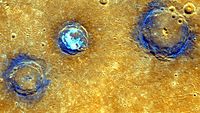


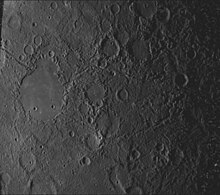
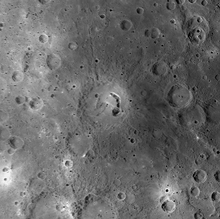

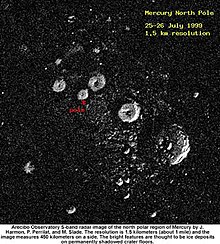





تعليقات
إرسال تعليق